Treadling: A Tale of Two Meanings
Marcy Petrini
Jujy, 2020
The word “treadling” is used in one of two ways, which, unfortunately can cause a lot of confusion. These are the definitions:
- Given a threading, treadling is the sequence of shafts activated (either raised or lowered depending on the loom) which produces the desired pattern or motif.
- Treadling is the order in which treadles, tied to a specific tie-up, are used.
These two sound the same, but they aren’t. The treadling-as-a-sequence-of-shafts is independent of loom, meaning that if I give you that sequence, you can weave that pattern. Even if we switch raising and lowering shafts, the same fabric is produced, with the top and bottom on the loom reversed.
The second without its tie-up is ambiguous. And the treadling-as-the-order-of-treadles is meaningless for someone who weaves with a direct tie-up, for example a table loom, or with a dobby.
So, be cautions of your use. Several years back, a beginning student relocated, bought a table loom, and joined a guild in her new location. After having woven a few plain weave items, she decided to try a pattern. She asked a guild member what would be the next best thing. “A straight twill, said the guild mate, you thread it as in plain weave, 1, 2, 3, 4, and you also treadle it 1, 2, 3, 4.” And showed her a fabric like this:
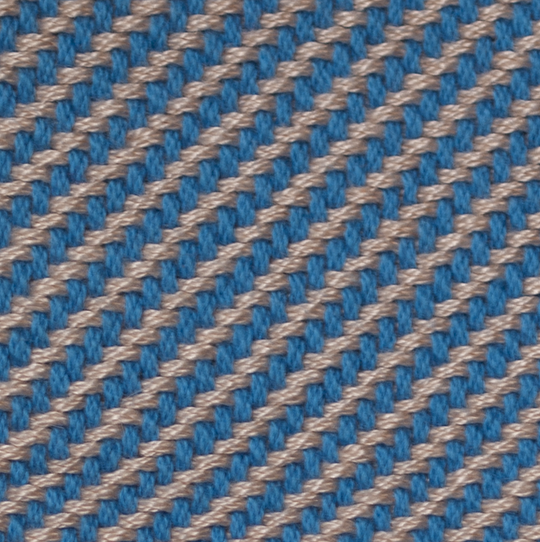
My former student went home and wove this:
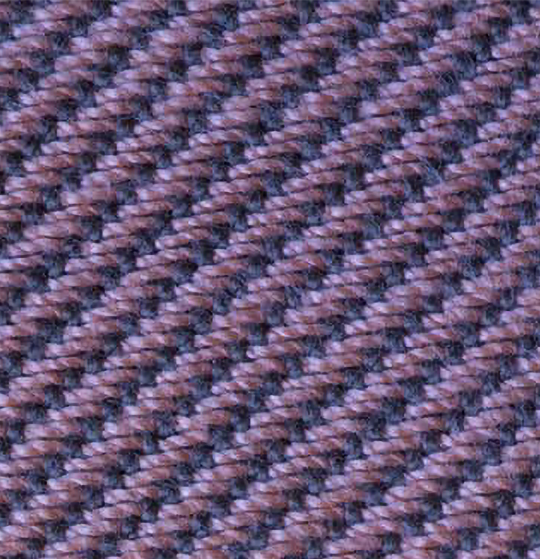
She used the drawdown below. She understood the treadling-as-a-sequence-of-shafts to be 1, 2, 3, 4.
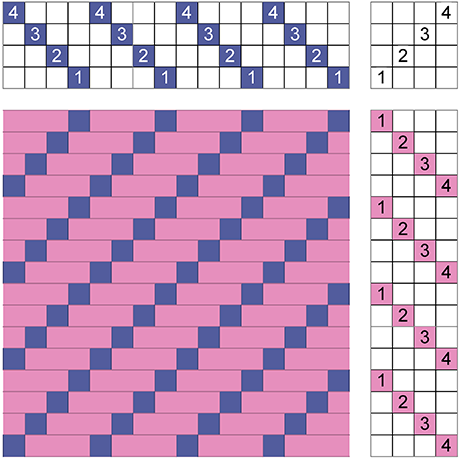
Given that she had no other information, that’s a reasonable thing to conclude. What the guild mate meant, however, was treadling-as-the-order-of-treadles, shown below, which is generally for a floor loom.

Furthermore, the guild mate assumed a “standard” tie-up, but that, too is confusing. The “standard” tie up on 4 shafts is all the possible combinations of shafts activated two at a time. There are 6 possible combinations. All of the tie-ups below would be considered “standard”, yet, for any treadling-as-a-sequence-of-shafts to produce a given pattern, each of these tie-ups would have different treadlings-as-the-order-of-treadles. How one ties those treadles to shafts at any given time and loom is a matter of preference and weave structure:
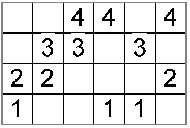 |
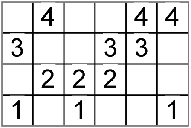 |
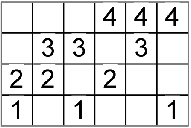 |
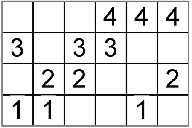 |
Back to my weaving student. If asked what is the treadling for the fabric my student wove, I would say:
| 1 |
| 2 |
| 3 |
| 4 |
| Repeat |
For the treadling of the fabric she wanted to weave I would say:
| 1 & 2 |
| 2 & 3 |
| 3 & 4 |
| 4 & 1 |
| Repeat |
Now my student could go to her table loom and weave it this way:
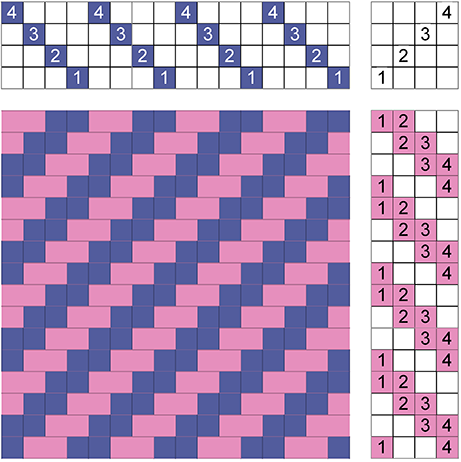
This drawdown is identical to the previous one with a 2/2 tie-up. My directions would be unambiguous.
Now let’s consider another common use. I am weaving a set of placemats, using a pointed twill; for each one, I will change the treadling without changing the tie-up, the tie-up without changing the treadling, and changing both the tie-up and treadling.
Here is my original pointed twill, tromp as writ:

Here are the treadlings:
|
as the order of treadles |
as a sequence of shafts |
|
| 1 | 1 & 2 | |
| 2 | 2 & 3 | |
| 3 | 3 & 4 | |
| 4 | 4 & 1 | |
| 3 | 3 & 4 | |
| 2 | 2 & 3 | |
| Repeat | Repeat |
For my next placemat, I am going to change the treadling to bird’s eye:
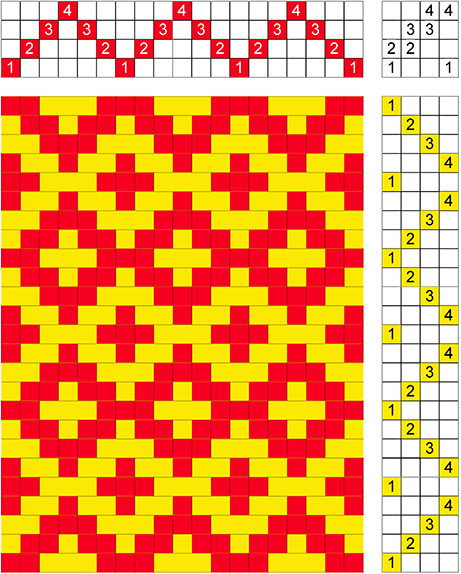
Here are the treadlings:
|
as the order of treadles |
as a sequence of shafts | |
| 1 | 1 & 2 | |
| 2 | 2 & 3 | |
| 3 | 3 & 4 | |
| 4 | 4 & 1 | |
| 1 | 1 & 2 | |
| 4 | 4 & 1 | |
| 3 | 3 & 4 | |
| 2 | 2 & 3 | |
| Repeat | Repeat |
Compare this drawdown with the previous one. The patterns are different as you would expect.
Now I am going to change the tie-up but use the same treadling as the original pointed twill:

The drawdown is different than the tramp as writ, because, even though the treadling-as-the-order-of-treadles hasn’t changed, the treadling-as-a-sequence-of-shafts has:
Treadling-as-the-order-of-treadles
| Original | New Tie-Up | |
| 1 | 1 | |
| 2 | 2 | |
| 3 | 3 | |
| 4 | 4 | |
| 3 | 3 | |
| 2 | 2 | |
| Repeat | Repeat |
Treadling-as-a-sequence-of-shafts
| Original | New Tie-Up | |
| 1 & 2 | 1 & 2 | |
| 2 & 3 | 3 & 4 | |
| 3 & 4 | 1 & 3 | |
| 4 & 1 | 2 & 4 | |
| 3 & 4 | 1 & 3 | |
| 2 & 3 | 3 & 4 | |
| Repeat | Repeat |
So, when you use that terminology, saying that you changed the tie-up without changing the treadling, make sure that you – and your audience – understand that you are in fact changing the treadling-as-a-sequence-of-shafts, or the pattern wouldn’t change. And users may need the treadling-as-a-sequence-of-shafts because different weavers prefer different tie-ups, and some don’t use tie-ups at all.
If we change the tie-up and the treadling from the original pointed twill, we will change the pattern as expected:
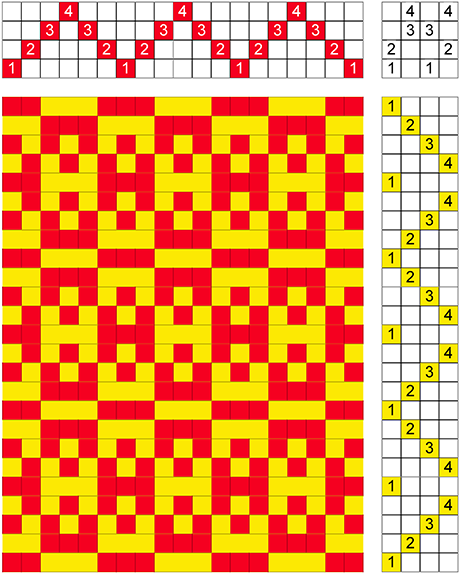
The treadling-as-a-sequence-of-shafts now is below, even though the treadling-as-the-order-of-treadles has not changed from the bird’s eye treadling:
|
as the order of treadles |
as a sequence of shafts | |
| 1 | 1 & 2 | |
| 2 | 3 & 4 | |
| 3 | 1 & 3 | |
| 4 | 2 & 4 | |
| 1 | 1 & 2 | |
| 4 | 2 & 4 | |
| 3 | 1 & 3 | |
| 2 | 3 & 4 | |
| Repeat | Repeat |
Here is another example where both the tie-up and the treadling were changed:
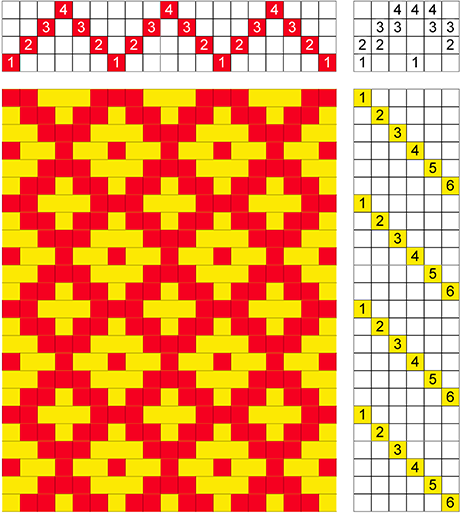
And we expect the drawdown to change… but it doesn’t!
 |
 |
That’s because the treadling-as-a-sequence-of-shafts hasn’t changed, it’s still:
| as a sequence of shafts |
| 1 & 2 |
| 2 & 3 |
| 3 & 4 |
| 4 & 1 |
| 3 & 4 |
| 2 & 3 |
| Repeat |
When I weave a pointed twill that has 6 steps in the treadling-as-the-order-of-treadles, I prefer my order of treadles to be straight, it makes my weaving faster than having to go back and forth with the conventional tie-up.
Next time you talk about a treadling, make sure that you are clear which use you mean - treadling-as-the-order-of-treadles or treadling-as-a-sequence-of-shafts – and if you hear someone talk about a treadling, determine which use of treadling is being discussed, and, if in doubt, ask.
Happy treadling!
Happy Weaving!
Please email comments and questions to marcypetrini@gmail.com.
